Updated 2024 to improve clarity throughout and to remove the discontinued Echo series.
Rogue has so many models of power racks and squat stands that choosing between them is overwhelming at first. I’ll be narrowing it down to just a few racks that in my opinion are the right choice for 90% of people.
Table of Contents
Why Rogue
Rogue has an excellent reputation for build quality, customer service, and overall reliability. Their products are well-designed and tested. They make all racks in their huge facility in Ohio while other companies mostly import from China.
Out of all brands, Rogue easily has the best resale value. It’s the most recognized top-tier brand of rack in the consumer market. A Rogue rack you might be able to resell after a few years for 80% of its retail price if it’s in great shape.
They have innovated dozens of new accessories to add to power racks. Other manufacturers have copied Rogue’s rack sizing to be compatible with their accessories, but sometimes there are slight incompatibilities. When you get a Rogue rack you know you’ll be in a good situation for adding accessories later on.
All of Rogue’s power racks are a “walk-through design”, meaning built without a lower rear stabilizer bar that would only get in the way of the proper positioning of a weight bench.
Their range of rack models is extensive, to the point of being overwhelming if you don’t know what to look for. It also means you can get exactly the right rack for you when you get some good advice (which hopefully you’ll get here!).
Squat Stands and Wall-Mounted Folding Racks
See my guide on choosing between power racks and squat stands.
I’ll probably write an article soon about Rogue’s several squat stands.
Also see the folding wall-mounted racks guide that goes over Rogue and other companies.
Rogue’s Series of Power Racks
The first thing you should know is the difference between their Infinity, Monster Lite, and Monster racks, so that I can guide you through eliminating a good chunk of them as possibilities and make it clearer what your best pick is.
The main technical difference between the three series is their tubing size and hardware size (ie: bolt thickness).
| Series | Size |
|---|---|
| Infinity / R-Series | 2″x3″ Tubing, 5/8″ Hardware |
| Monster Lite | 3″x3″ Tubing, 5/8″ Hardware |
| Monster | 3″x3″ Tubing, 1″ Hardware |
The Infinity were Rogue’s first racks, also known as the R-Series that contained the very popular R-3 rack which is still sold today. 2×3 racks such as this were common in the early 2000s before Rogue, and they went with the proven size. It’s a good tubing size for reducing wobble, and it makes for reasonably heavy racks that stay in place. This series got de-emphasized a few years ago, and newer attachments are not all available for Infinity racks, although Infinity racks and many attachments are still being produced. A few years ago it appeared to me that Rogue was phasing out Infinity racks entirely, but that has not happened yet.
Next up, bigger tubing in the Monster Lite means a more heavy duty rack overall. You get less wobble in all directions and less risk of tipping with the added weight. More attachment options too. On the downside, you’re paying more, and you’ll be paying more on the back end with more expensive attachments.
Finally, the Monster goes a step beyond the Monster Lite with bigger 1″ hardware. Why 1″ hardware? Technically that makes it stronger. The Monster racks have a few premium options available too, such as extra height.
I’ll be mostly focusing on the Monster Lite racks for this article. See the last couple sections of this article for several considerations that might make you choose an Infinity or Monster rack.
In 2022, Rogue discontinued the last of their Echo series of racks. I have therefore removed the Echo racks from consideration in an update of this article. They were 2″x2″ tubing and 1/2″ hardware. The 11-gauge steel and good design features made them notably better than cheap 2×2 racks from Amazon. For what ever reason, Rogue made the decision to no longer compete in the market of those lighter racks.
Top Pick: RML-390F
I featured this rack in my Best Freestanding Power Racks article.
Rogue makes hardly any freestanding racks, meaning one that isn’t meant to be bolted to the floor to be stable.
With the RML-390F you don’t have to worry about drilling holes into concrete or making a plywood platform for it. Just set up and go. This is a popular, basic rack that you are unlikely to regret getting.
Here’s an explanation of what makes this rack so stable…
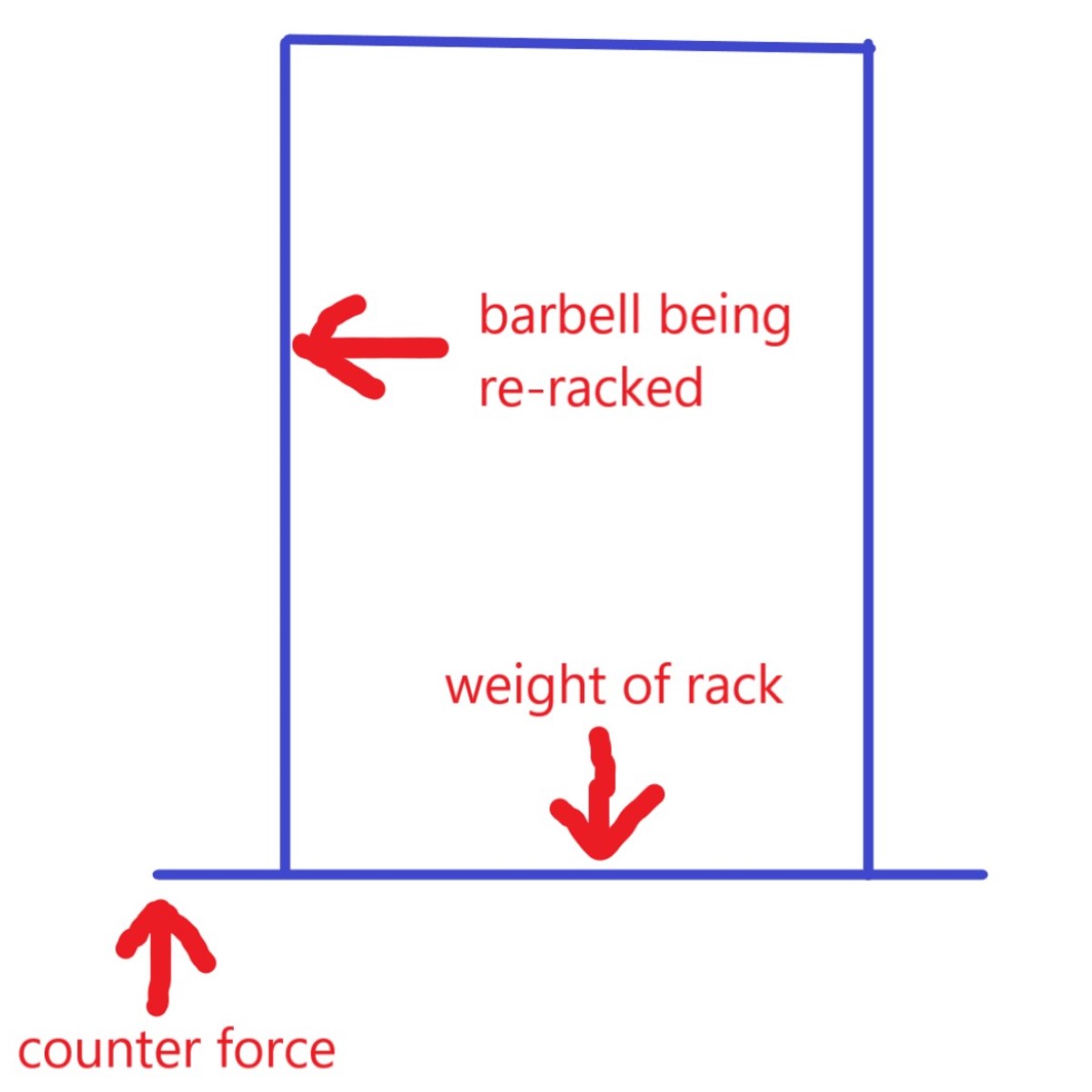
The stability of a freestanding rack like this isn’t exactly due to the “flat foot” design so much as it is the feet that extend past the uprights to create a counter-force against tipping when you re-rack a loaded barbell. Without the extended feet, there is no counter-force and the rack can easily tip.
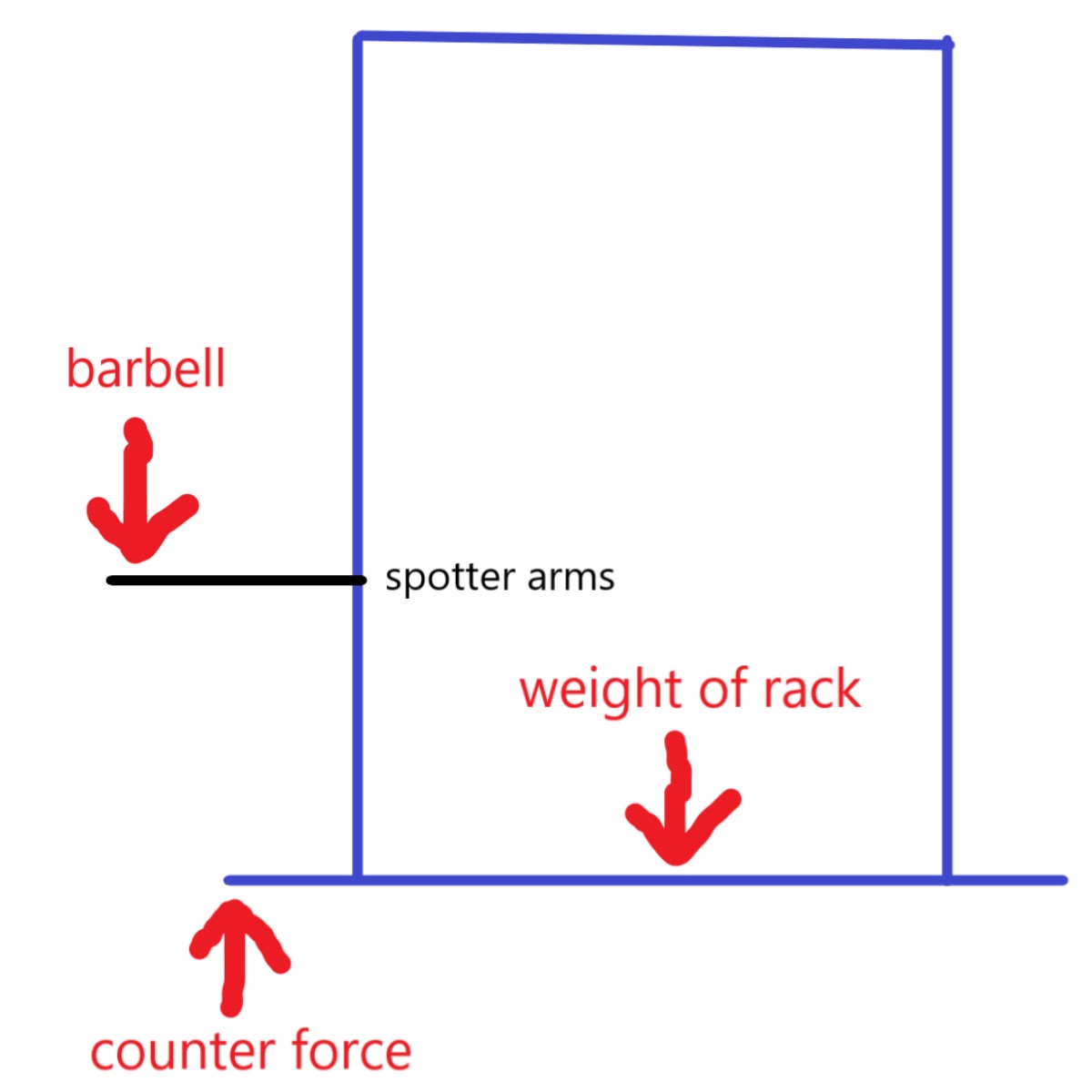
On that same principle, be careful about adding front spotter arms to this rack. The extended feet do not provide as much of a counter-force to prevent tipping when the spotter arms extend past them.
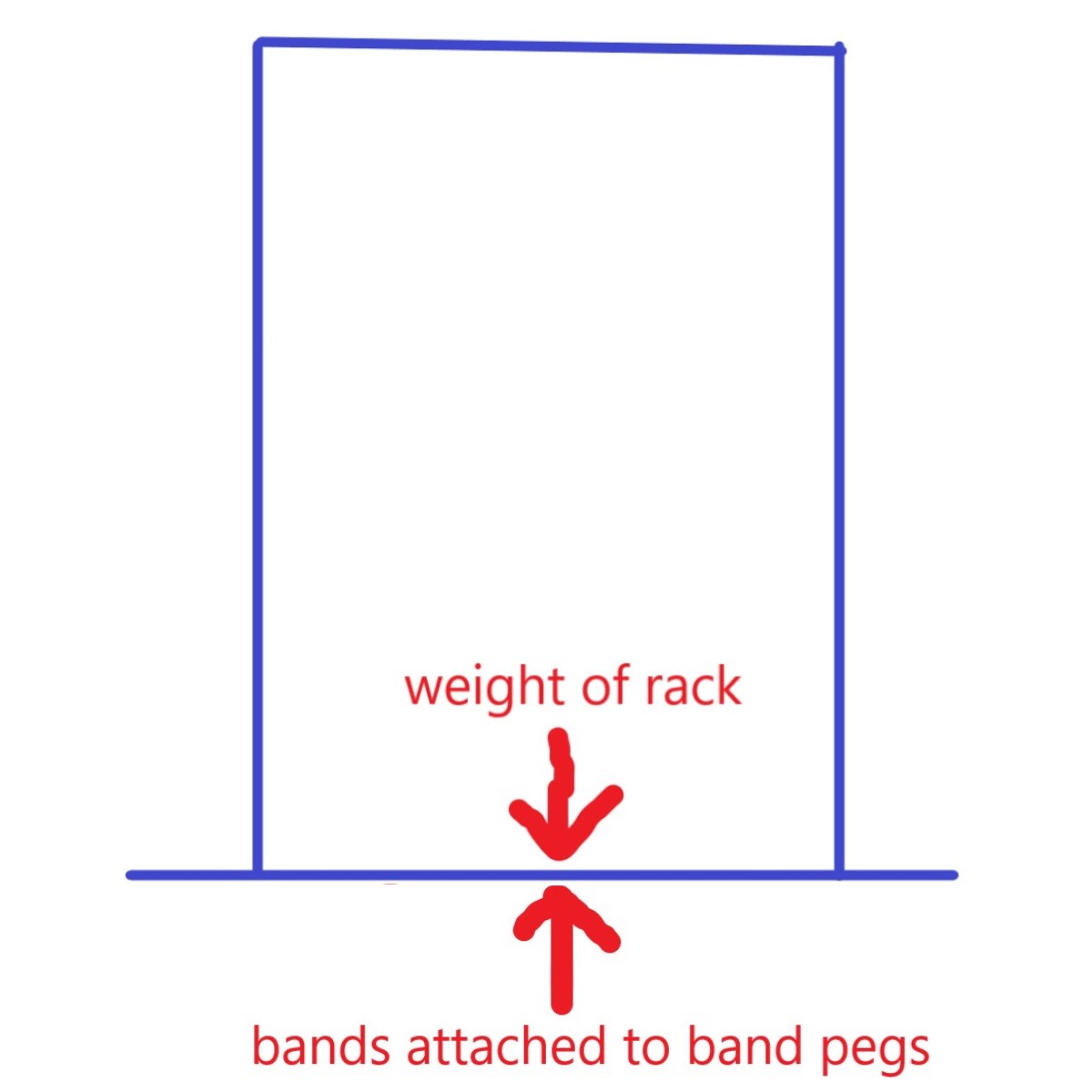
This rack does come with band peg holes, but without band pegs. You can inadvertently lift up the rack if you’re using heavy enough bands. For that reason, Rogue recommends you do NOT use band pegs on this rack. If you want to, test your bands out carefully with an empty bar to make sure the rack is heavy enough to handle them, including racking the bar forcefully. The rack could tip when you rack a loaded bar, much as if you’re using a lighter rack.
Basic Floor-Mounted Pick: RML-390C 3.0
Based on the classic R-3! A good basic floor-mounted rack.
The rack comes standard with band pegs and a choice of colors. Optionally you can add numbered uprights, strap safeties, and concrete anchors.
It has the signature “Westside” hole spacing, which is 1″ hole spacing in a lower area of the rack for the bench press area, and 2″ hole spacing above.
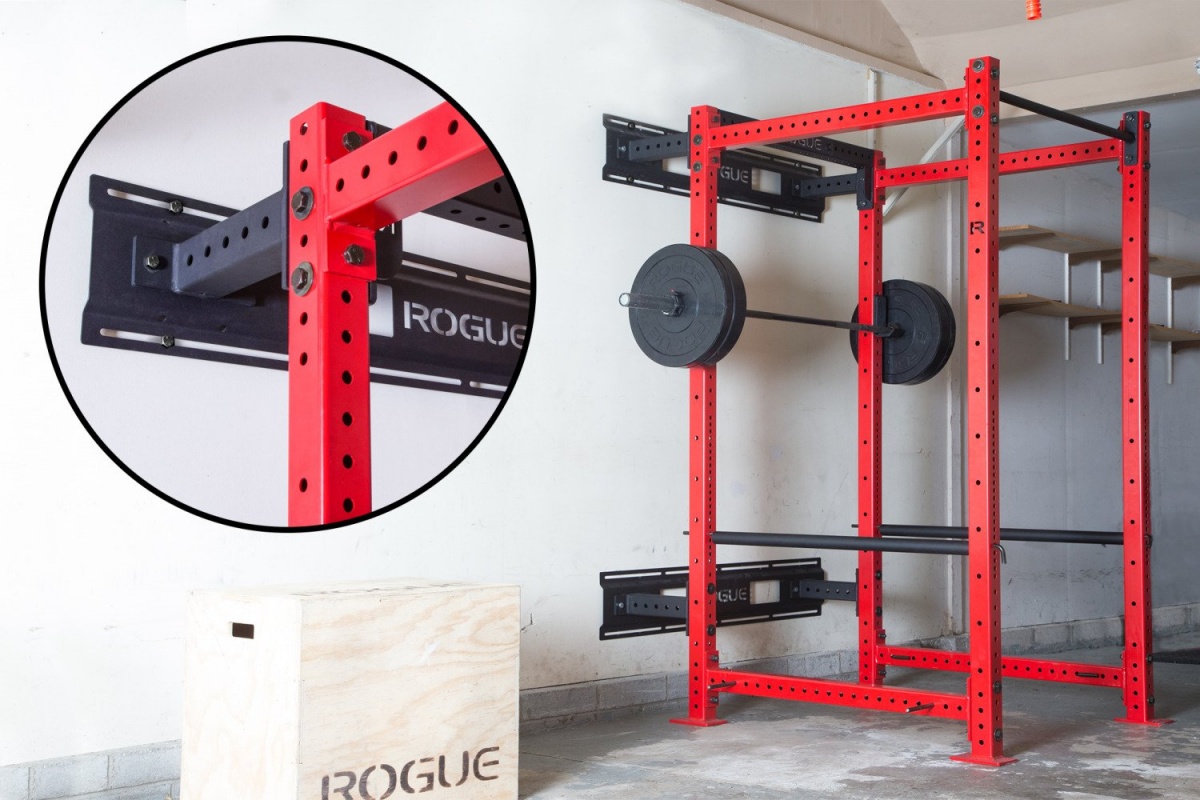
The wall-mount rack kit is a space-efficient way to stabilize the RML-390C by mounting it into the wall, should you prefer that over drilling holes to mount it to your concrete floor. One way or another, it should be mounted.
If You Have the Space: RML-690C 3.0
You have to store your plates somewhere. If your floor plan allows it, having your plates on the rear of a 6-post rack like this is more convenient than on a plate tree. It’s also more stable.
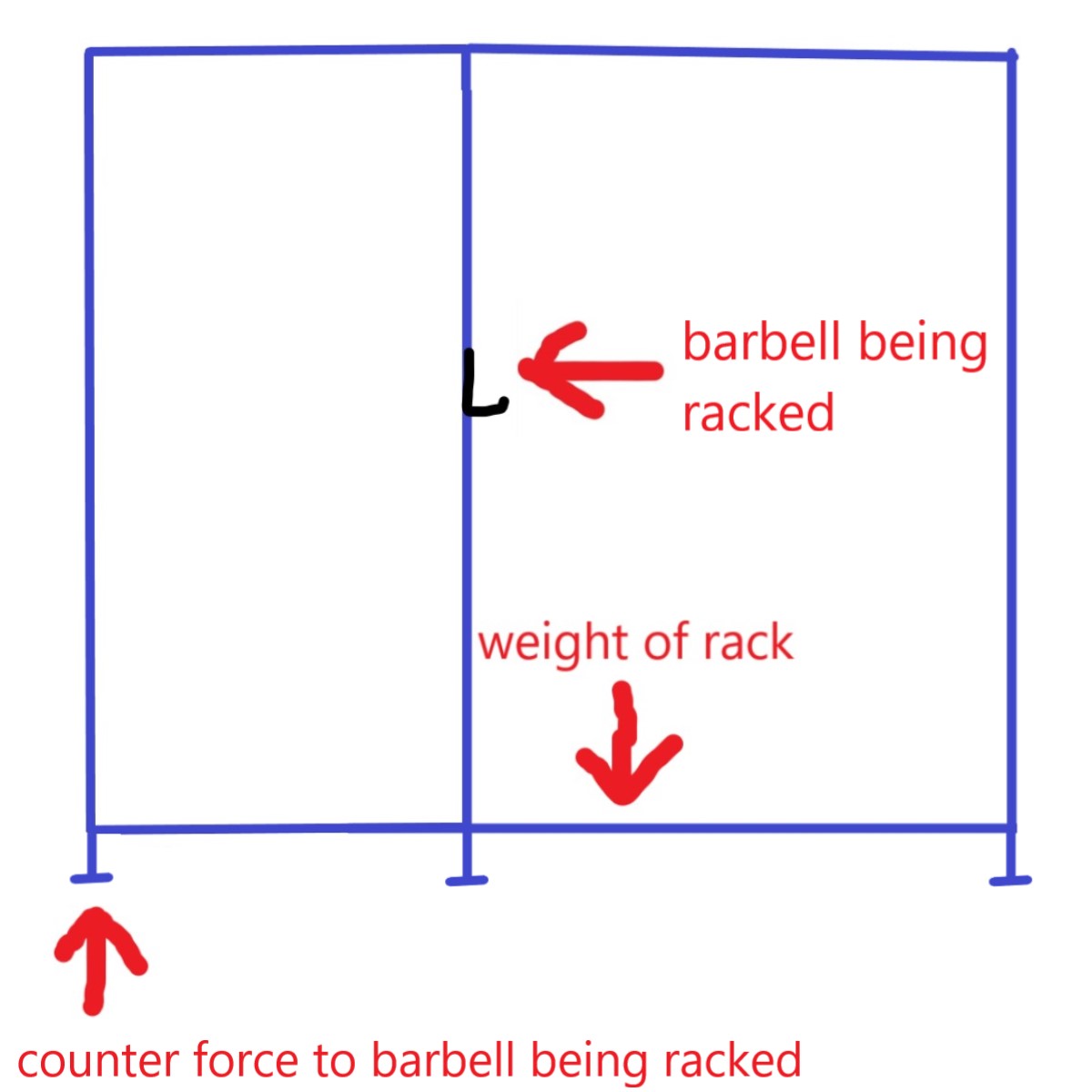
Technically, this rack is meant to be bolted down, but the extended rear portion of the rack provides so much counter-force leverage against a barbell being re-racked, as illustrated, and extra frame weight (+160lb), that people have found that they can get away with leaving it freestanding without issue. On bare concrete it could slide. Rubber flooring holds it in place fine.
Like the RML-390C, the rack comes standard with band pegs and a choice of colors, and optional numbered uprights, strap safeties, and concrete anchors.
Monster Rack Equivalents
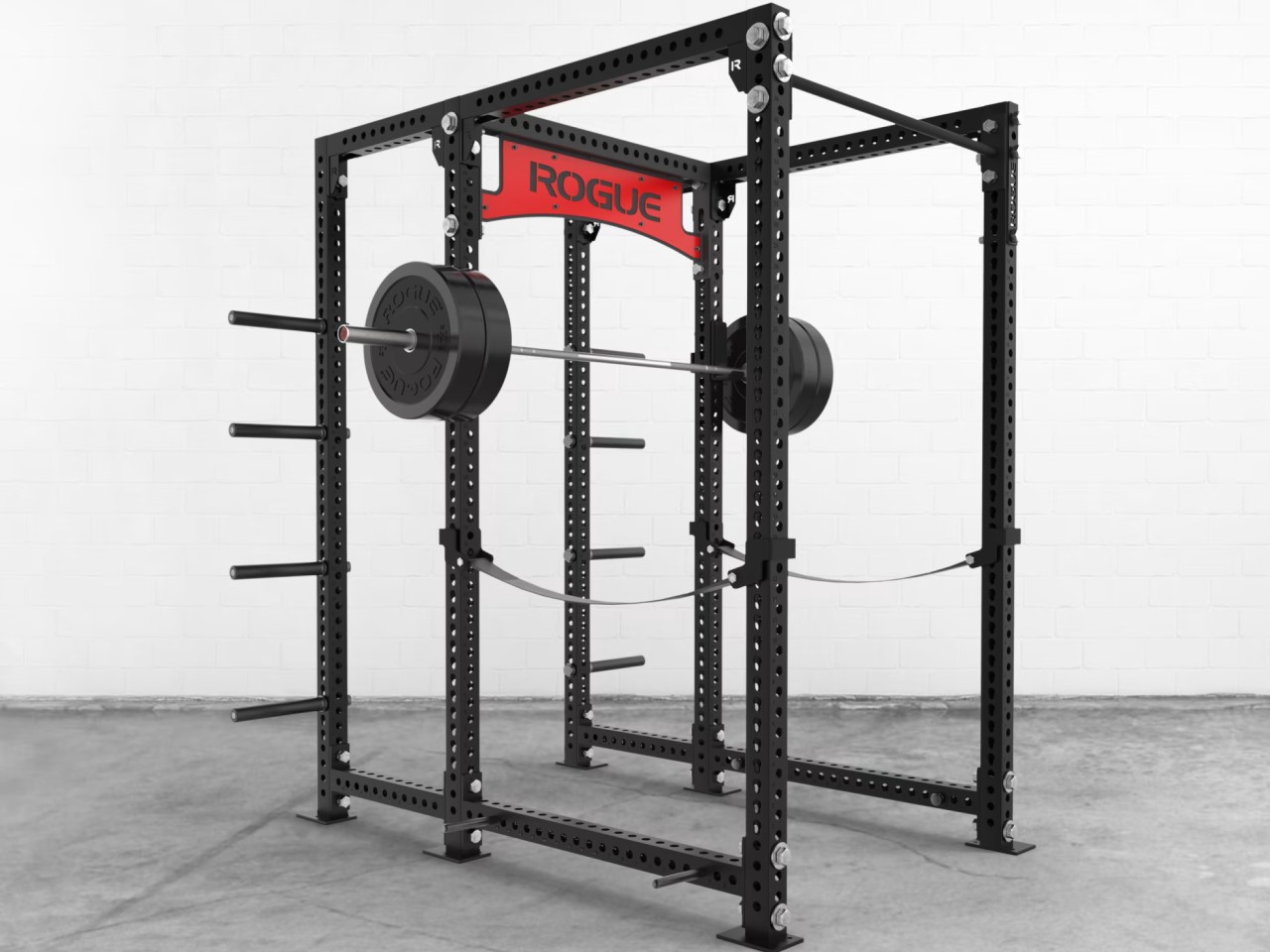
I can’t really recommend you get a Monster rack unless you have a specific justification for it, which I’m outlining here. The Monster Lite is generally as heavy and as strong as anyone will ever need.
All three of the Monster Lite models I recommend in the sections above have corresponding Monster models: The freestanding RM-390F, the 4-post RM-4, and the 6-post RM-6.
Here’s what you’re looking at in the Monster series racks over the Monster Lite:
| Monster Lite | Monster | |
|---|---|---|
| Hardware Size | 5/8″ | 1″ |
| Hardware Finish | Black Zinc | Optional Bright Zinc |
| Height Options | 90″ | 90″, 100″, 108″ |
| Pullup Bar | Regular | Regular + Fat and other options |
| J-Cups Upgrade | No, you have to buy the standard and pay full price for the upgraded ones. | Yes, upgrade for reduced price. |
| Flip Down Safeties or Strap Safeties Upgrade | No, you have to buy the standard and pay full price for the upgraded ones. | Yes, upgrade for reduced price |
The 1″ hardware is made for a tank. Very hard to justify that logically. Same with the bright zinc hardware finish option. These are glamour features.
The height options start to make sense. If you have the ceiling room, it’s nice to be able to do overhead presses inside the rack with no restriction, and to get a full hang on the pull up bar.
Speaking of the pull up bar, the Monster gives you a fat pull up bar option for a more challenging grip.
If you’re going to be getting sandwich J cups or some strap safeties or flip down safeties, they let you upgrade to those without forcing the standard ones on you the way they do with the Monster Lite. The price savings there barely cuts into the overall price difference of the rack, but it’s worth a consideration.
Other than those upgrades when you buy the rack, the attachments will cost you a little more on the Monster.
It doesn’t look to me like there are any attachments right now for the Monster that aren’t available in Monster Lite, but I believe I have seen a Monster version of one or two attachments made first, kind of a perk for the Monster owners.
Tubing Size and Safety
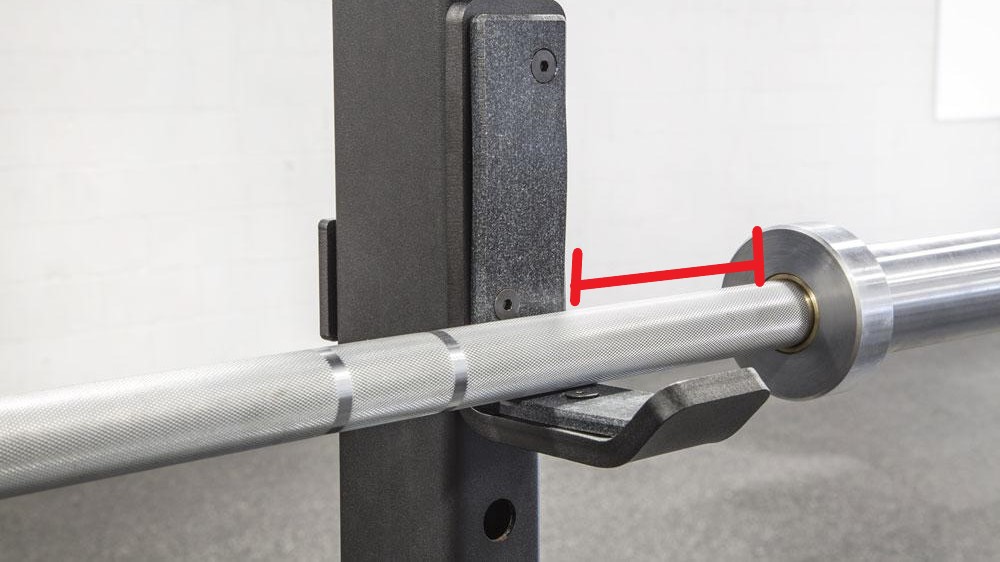
There is one upside to 2×3 racks, and that is the fact they are not as wide on the outside dimension, causing your bar to be an easier fit.
Above is an Infinity rack, and to be clear, the tubing is 2″ wide and 3″ deep. In this example the bar is pulled a little to the right and is not centered. With the bar centered the red marked space will actually be about 2.25″, which is still pretty good.
Now consider Rogue’s 3×3 racks. The way Rogue designs them, they keep the same “inside” width of the rack and extend the tubing width outwards. That is to say, while the Infinity racks are 47″ wide, the Monster Lite racks are 49″ wide. Now your bar only has 1.125″ of space on each side to move laterally before you’re in trouble!
This obviously raises the risk of problems. You don’t want the plates or shoulder of the bar to bump against the upright because you’re off-center a little too far. The heavier the weight, arguably the more likely you are to find yourself off-center in a set of squats that you are struggling to control, and potentially the heavier the consequences.
A way to mitigate this on Monster or Monster Lite racks is with sandwich J-cups. Yes, they are expensive. Think about getting them later on, at least. In this situation, because they are narrower than regular J-cups and stick out from the uprights, you have more lateral movement space for your bar, making it as safe as using an Infinity rack.
As I said in the beginning, this article is not meant to be an exhaustive comparison of all Rogue power racks. But at this point you understand the basic considerations, and if another model catches your eye you’ll be able to put it in the right context. Don’t spend too much time waffling on it when one makes sense to you. They’re all great racks. Just get one, and start lifting!

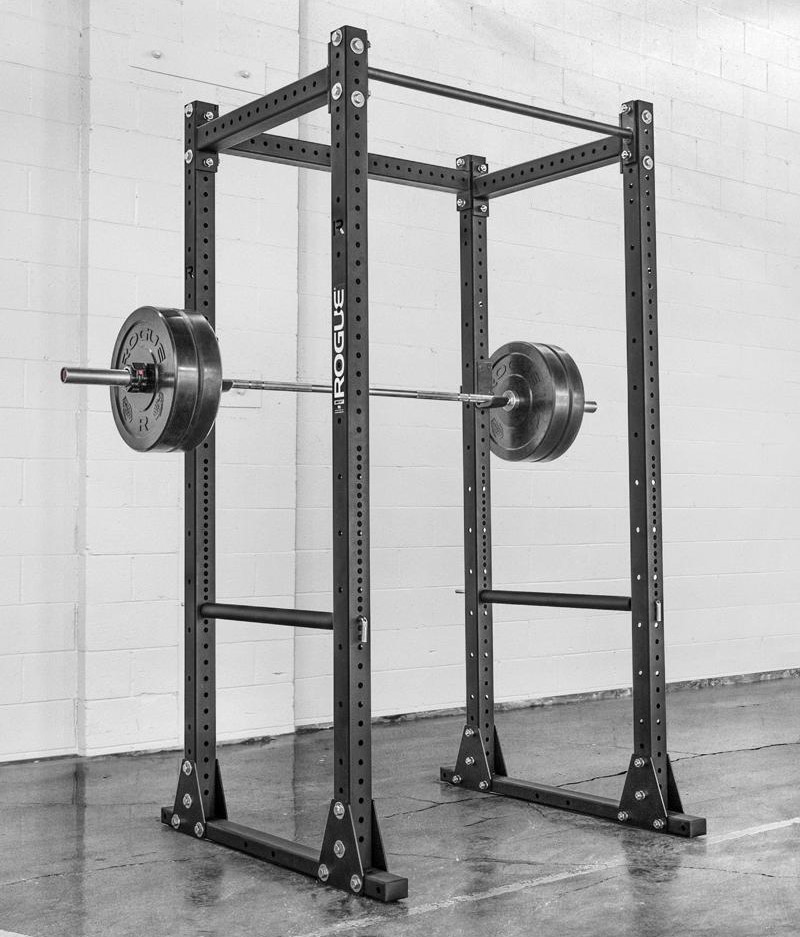
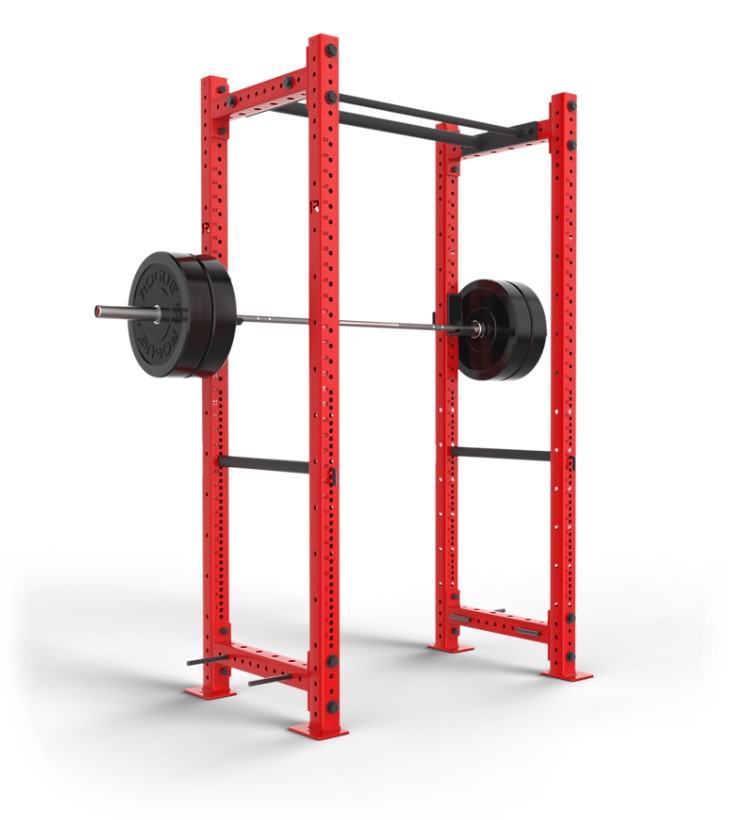
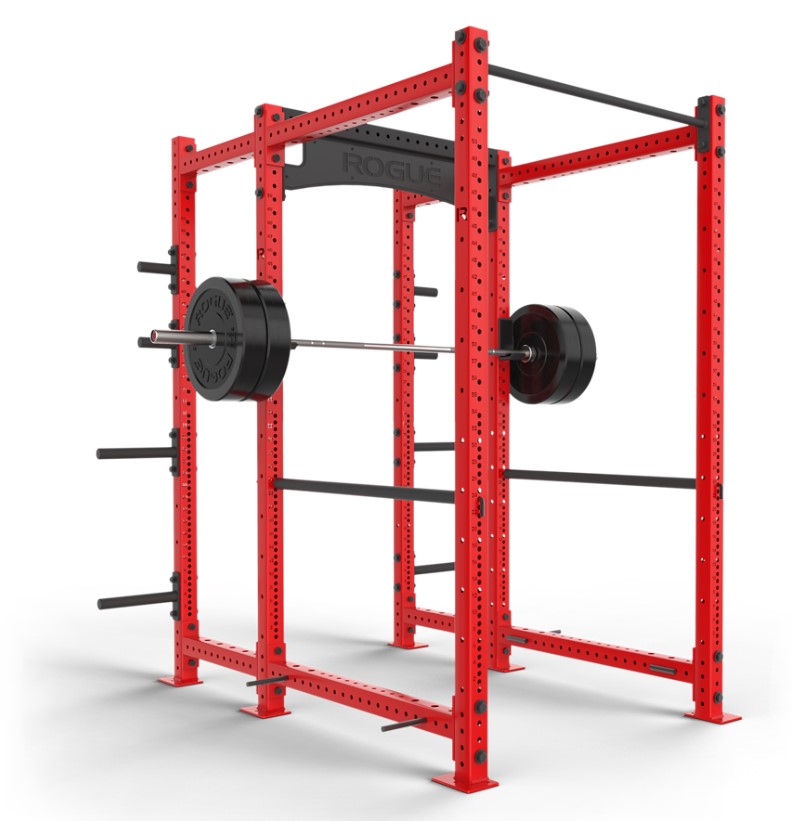
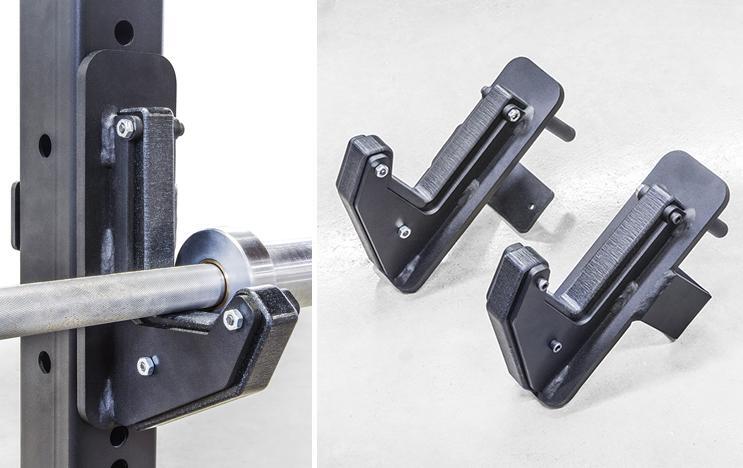
Great article – super helpful!
Thanks for reading!
I just found this site. This is awesome! Thanks for this! Monster Lite it is….
Good choice, you’ll love it
I would say the different heights available for Monster line make it a better option for taller people. The monster lite is only 90”
Good point. I wish they had an option for taller Monster Lite racks, but I guess this is why people go with Monster. Somehow this obvious point escaped me when I was writing!
The Froning Rack is 100 inchs which makes it inline with the most of the Monster racks options for height
The Froning rack would be cool for taller people. I’m 6ft and wouldn’t mind something like that if I had the ceiling height! Here’s a link for anyone curious.
https://www.roguefitness.com/rogue-froning-rml-4100c-power-rack
I’ll be revising this article soon to dump the R-series racks I think. Rogue appears to be moving away from all the 2×3 racks in favor of 3×3, and the availability of the best attachments into the future for 2×3 is questionable.